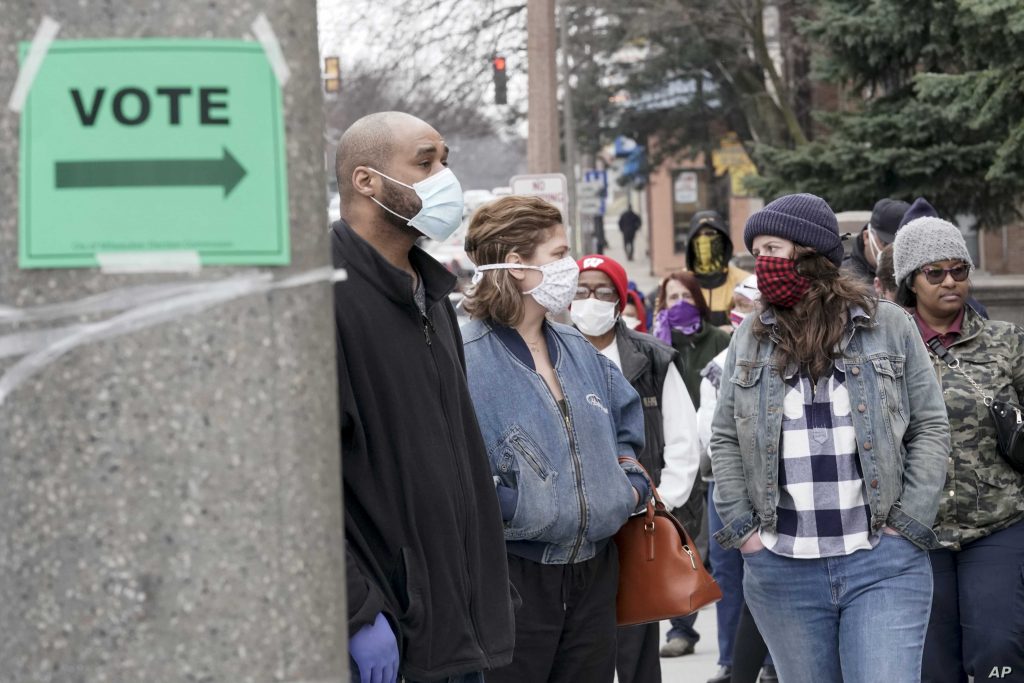


By Kathleen Struck
Digital Managing Editor and Education Editor
Student Union
Voice of America
Millennials and GenZers have seen more than most generations in their young lifetimes: a terrorist attack on U.S. soil in 2001, two economic crashes and record unemployment, extreme weather events, divisive politics and a global pandemic.
And most recently, social unrest in response to the death of George Floyd, an African American man who died after being restrained by Minneapolis police.
“Millennials Don’t Stand a Chance,” economics journalist Annie Lowrey wrote for The Atlantic in April.

Yet there are plenty of signs that young Americans could play a major role in the 2020 election, helping to determine the outcome of the race between Republican President Donald Trump and Democratic challenger Joe Biden, as well as political control of Congress, and beyond. Their record turnout in the 2018 midterm elections, signs of political activism, and a handful of issues being used as a rallying cry, including soaring college debt, health care and climate change, stand as evidence.
“Young people can decide elections, and their participation is central to our politics. Expanding the electorate and addressing inequities in youth voting is a crucial task for strengthening democracy,” according to the Center for Information and Research on Civic Learning and Engagement (CIRCLE) based at Tufts University in Massachusetts.
While younger generations mimic their elders when they were young — by not engaging at the voting booth — the 2018 midterms saw an upsurge in participation.
Election involvement
Millennial voting nearly doubled between 2014 and 2018 — from 22% to 42% — according to demographer Richard Fry at the Pew Research Center in Washington. Thirty percent of Gen Zers eligible to vote turned out in the first midterm elections of their lives. And for the first time in a midterm election, more than half of Gen Xers reported they had voted, Pew reported.
“This 2020 election cycle is particularly interesting because, for the first time in almost over 25 years, we’re moving from a midterm election where young people’s participation dramatically increased,” Abby Kiesa, CIRCLE’s director of impact, said.
“Now there are 47 million 18- to 29-year-olds who are eligible to vote in the 2020 election, and 15 million of them have turned 18 since the last presidential election,” Kiesa said.
While young people — millennials born 1985-1995, GenZers born in 1996 onward — are casually viewed as a homogeneous group of like-minded thinkers, research shows otherwise.
In the 2018 midterm elections, two-thirds of all young voters age 18-29 supported the Democratic candidate for Congress. That’s the widest party gap in the past 25 years, CIRCLE said.
And the 2020 election will happen amid a huge demographic shift, said Jesse Barba, senior director of external affairs at Young Invincibles, a youth voting and political advocacy group “to expand economic opportunity for our generation.”
The U.S. population is poised to move from majority white to majority minority, or mostly non-white voters, by 2045, according to Brookings Institution.
“This would be the first time in history where nonwhite people make up the largest electorate,” Barba said. “I think for so long people have been talked down to rather than included and talked with, so … any candidate who wanted to motivate and mobilize young people should have tried to speak about four or five key things.”
Key issues to young voters
Those key issues include college debt, affordable health care, expanding voter rights, gun violence, immigration, climate change and economy, he said.
“I think the public health crisis has now put two issues top-of-mind squarely for young people, and that’s economy and mental health,” Barba said, citing record unemployment driven by the coronavirus pandemic and widespread shutdowns of businesses, such as restaurants, bars and retail, which all typically employ younger people and seldom provide benefits.
“Many of those young people [are] disproportionately working in industries that are hit the hardest, right? So not only are they losing their jobs, they’re also at risk of losing that job-based health coverage or inability to afford their own individual plans,” Barba said.
“Healthcare probably is huge for me,” said Paul Haarstick of Vergas, Minnesota, who lost his health care benefits when he pivoted from a corporate job with corporate benefits to be an entrepreneur. Haarstick is also the county director for Otter Tail County in the Democratic Farmer Labor Party.
“Since our healthcare system is tied with ‘employment equals health insurance,’ … there’s no real good second option for an entrepreneur. You pay more for healthcare and you get worse coverage.”
Health care costs added to student debt costs are subtracted from salaries that can’t cover everything.
“Is it fair that an entire generation lost out on a decade’s worth of wages in 2010 in the Great Recession?” he added, referring to the banking collapse in 2008 and resultant economic downturn.
For college graduates at the time, especially those carrying student debt, jobs were hard to come by.
“Is it fair that an entire generation press ‘pause’ on family planning and had to crawl back to mom and dad’s house? No,” he said. “So I think that is a constant reminder for young people when they walk into the ballot box in November.”
Former pastry chef and author Alechia Dow, who writes Young Adult sci-fi featuring black girls, tweeted about student debt this week, along with hundreds of others who share laments about debt burden on Twitter.
“It’s my dream to one day own a house, with brightly painted walls and a big kitchen with an island,” she wrote. “But then I look at my student loan debt, and that’s as much as a house, so I know that dream is impossible.”
Young white males
One voting bloc that takes a different path are young, white, male voters, statistics show. “They form a sizable and sometimes disproportionate swath of the American electorate,” CIRCLE said.
Young white men voted at a higher rate than young Latino and black men, according to CIRCLE’s analysis of the 2018 Current Population Survey data, which is produced by the Bureau of Labor Statistics and the Census Bureau. In the last presidential election, the bloc also preferred Donald Trump over Hillary Clinton by 22 percentage points.
Young men of color and young women, conversely, preferred Clinton, by from 15 to 60 percentage points, CIRCLE said.
And in some key swing states — Iowa, Ohio and New Hampshire — young white men make up a larger share of the population compared to national averages.
Five months before the U.S. general election in November, the pandemic continues, unemployment remains high and many young people, especially people of color, are advocating for racial and social justice after the death of George Floyd and other similar incidents and inequities in American society.
“You can tweet about it. You can hashtag about it. You can be upset about it and share the video,” said Markus Tarjamo, a student and Democratic National Convention delegate candidate from suburban Washington. “But until we start going and taking political power, not much will change.”
CIRCLE’s Kiesa says that attitude could spark other young people to activate at the polls.
“And so we’re really interested in following how much that youth enthusiasm, how much that energy from young people and reaching out to other young people, is going to carry in to 2020,” Kiesa said.
Originally published by Voice of America, 06.22.2020, under a Government Public Domain license.
